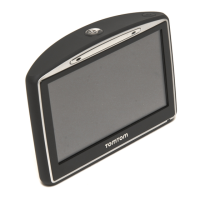
Do you have a question about the TomTom Go 730 and is the answer not in the manual?
| Auto | Yes |
|---|---|
| Marine (chartplotters, sounders) | No |
| Form factor | Fixed |
| Product color | Black |
| Display diagonal | 4.3 \ |
| Display resolution | 480 x 272 pixels |
| Native aspect ratio | 16:9 |
| Internal memory | 64 MB |
| Storage capacity | 2048 MB |
| Processor frequency | 400 MHz |
| USB 2.0 ports quantity | 1 |
| Battery life (max) | 5 h |
| Depth | 83 mm |
|---|---|
| Width | 118 mm |
| Height | 24 mm |
| Weight | 220 g |
Lists all items included in the TomTom GO package, including device, mount, and documentation.
Details items included with specific TomTom GO models, such as traffic receivers and remote controls.
Instructions on how to power the TomTom GO device on and off using the On/Off button.
Guide on initial setup, including language selection, for the TomTom GO device.
Provides recommendations for charging the battery and notes on battery usage for device settings.
Tips for ensuring optimal GPS signal reception and advice on potential windshield interference.
Important advice on handling and maintaining the TomTom GO device to prevent damage and ensure longevity.
Details the various elements displayed on the TomTom GO's Driving View screen for navigation.
Explains the automatic calibration process for Enhanced Positioning Technology (EPT) on the device.
Step-by-step guide on how to plan your initial journey using the TomTom GO device.
Details on how to subscribe to and use the real-time traffic information service.
Explains how the Traffic Message Channel (TMC) provides traffic updates via radio signals.
Instructions for connecting and enabling the RDS-TMC Traffic Receiver for traffic updates.
Step-by-step guide for inserting the batteries into the TomTom GO remote control.
Instructions on how to establish a Bluetooth connection between the remote control and the GO device.
Explains the meaning of indicator lights on the remote control.
Details the function of each button on the remote control.
Details how the device shows lane information for highway exits and intersections to aid navigation.
Explains how to find and contact emergency services and other specialist services.
Guide to setting safety preferences that enhance driving safety and focus.
Instructions on how to use voice commands to enter addresses for navigation.
Information about the community-based map correction technology and its features.
Details on playing MP3 files, audiobooks, and viewing photos on the TomTom GO.
Guide on connecting a mobile phone for making and receiving calls and messages.
Instructions on using the FM transmitter to play audio through the car radio.
Steps to install the TomTom HOME software on your computer for device management.
Information on finding tips and tricks for using the TomTom HOME software.
Guidance on creating a MyTomTom account for purchasing content and services.
Details what the limited warranty covers, including defects in workmanship and materials.
Specifies items and conditions not covered by the TomTom Limited Warranty.
Procedure for contacting TomTom and returning the device for warranty service.
Outlines user's legal rights and limitations of liability concerning the warranty.
Covers GPS, general use, aircraft/hospital restrictions, and battery safety guidelines.
Specific regulations regarding windshield objects and mounting for California and Minnesota drivers.
Details FCC compliance, radio frequency exposure, and interference guidelines.
Includes FCC Declaration of Conformity, Canadian emissions info, and FM transmitter country operation.
Information on C-tick, A-tick compliance marks, and specific warnings for Australia.
Information on TomTom trademarks, logos, and embedded software license agreements.
Credits for map data providers like Tele Atlas and Info USA.
Notices regarding technologies like Text to Speech, MPEG Layer-3, and Apple/iPod compatibility.